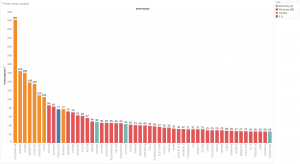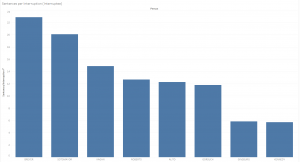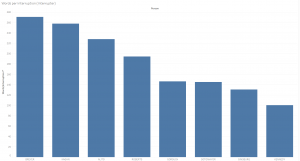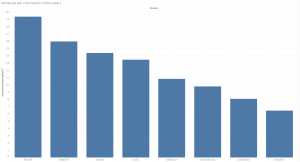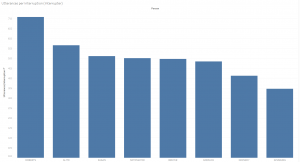Empirical SCOTUS: A little change will do you good — oral argument interruptions OT2017

on Aug 1, 2018 at 2:53 pm

Although female justices have only served on the Supreme Court since 1981, a relatively short slice of the court’s history, gender imbalances have existed in oral argument interruptions for many years, with female justices bearing the brunt of them. These imbalances were identified in a blog post on Empirical SCOTUS, with subsequent commentary from Stephanie Mencimer at Mother Jones. Other articles and scholarly papers (and here) then conducted deeper inspections of these interactions, with one study finding that these gender imbalances even extended to Supreme Court advocates.
Insights from these works became the subject of Justice Sonia Sotomayor’s remarks at the recent American Constitution Society convention. As the results of previous studies have reached a wide audience and, as Sotomayor claims, have been acknowledged by the justices, one might expect that the justices have rectified or attempted to rectify these imbalances.
Before investigating this claim with the 2017 term data, a quick note about the methodology. As with other studies on this subject, this post used a script to note each time a speaker’s remarks ended with a double-dash (“–”) rather than a period. Each speaker’s full speaking turn was coded as one utterance. Utterances end at the close of a sentence, with an interruption, or at the close of a segment of oral argument. If a speaker’s utterance ended with a double dash, then the initial speaker was coded as interruptee and the subsequent speaker was coded as interrupter. The script was developed and implemented by attorney Alexander Kappner.
All actors
Whether or not any changes have had an impact depends on the way we examine the data, but the results are hopeful. Sotomayor was far and away the most interrupted justice for the 2017 term when looking at interruptions by attorneys and justices.
Because Justice Stephen Breyer, the second most interrupted justice, spoke more total words at oral arguments this term than Sotomayor, Sotomayor’s words per interruption were much lower than Breyer’s in the aggregate. Beyond the justices, the attorneys interrupted the most (in terms of total interruptions) were Neal Katyal, Paul Clement and Solicitor General Noel Francisco. Only three female advocates made this list of most interrupted attorneys, which is likely more of an artifact of the infrequency with which female attorneys argued this term than of the justices’ propensity to interrupt female attorneys.
One possible explanation for the high number of times Sotomayor was interrupted might relate to the number of times she interrupted others. The next figure looks at the total number of times justices and attorneys interrupted others this term.
Sotomayor interrupted others this term far more than any other justice or attorney. Breyer followed suit in this area, as he did for times interrupted. In terms of total interruptions, the numbers appear to reflect a tit-for-tat in which the greatest interrupters were also interrupted the most and tended to have the most speaking opportunities. The attorneys who interrupted others the most times were Francisco, Katyal and Jeffrey Fisher. The only female attorney to make the list of most times interrupting others was Louisiana Solicitor General Elizabeth Murrill.
Just the justices
Looking only at justice-to-justice interruptions shows that a large portion of the interruptions counted above involve attorneys as interrupters or interruptees. The following figures include only interruptions between justices and are based on case averages so that each case is weighted equally (e.g., if Justice A’s interruption rate was 500 words/interruption in Case 1 and 450 words/interruption in Case 2, Justice A’s average words/interruption for the two cases would be 475). The first of these figures looks at the frequency with which a justice was interrupted relative to the number of words spoken by that justice per argument.
Breyer, the justice who spoke the most, was interrupted the least frequently according to this metric. After Breyer come Sotomayor and Justice Elena Kagan. Justices Samuel Alito and Neil Gorsuch fall to the middle of this figure, while Chief Justice John Roberts and Justices Ruth Bader Ginsburg and Anthony Kennedy were interrupted most frequently. At first blush this figure makes it seem as though the female justices were not interrupted more frequently than the male justices this term. The other measures support this point.
The figure for justices’ sentences per interruption for interrupted justices appears similar to, although not exactly the same as, the previous figure.
Breyer still comes in first with most sentences spoken per interruption. The only changes of the ordering of justices from the words-per-interruption figure pertain to Roberts, Gorsuch and Alito in the middle.
The figure for utterances or talking turns per interruption further supports the point that female justices were not interrupted more frequently than male justices.
Sotomayor actually had more utterances per interruption than any of the other justices. Breyer was the second least interrupted justice according to this measure and Kagan was third. Ginsburg was interrupted most frequently when looking at utterances per interruption, with Kennedy coming in as the next most frequently interrupted justice.
The other side of the coin tells a similar tale. When looking at the justices’ words per interruption while focusing on justices as interrupters, we get the following figure:
Similar to his frequency as interruptee, Breyer also spoke the most words per interruption when focusing on outward interruptions or when he was the interrupter. Kagan came next, also with a high number of words spoken per outward interruption. The justices who interrupted other justices most frequently when focusing on word count were Kennedy, Ginsburg and Sotomayor.
There are slight differences when looking at sentences per time interrupting.
Here, Breyer is also the justice who interrupted other justices the least frequently. Roberts and Kagan switch positions in this figure, as Roberts interrupted other justices less often than Kagan. The most frequent interrupters by sentence count were the same as for word count — Kennedy, Ginsburg and Sotomayor.
Lastly, looking at interruptions by utterance, there is a more substantial shift in the justices’ ordering.
Roberts and Alito were the least frequent interrupters by utterance, followed by Kagan, Sotomayor and Breyer, while Kennedy and Ginsburg were once again the most frequent interrupters.
The oral argument interruption terrain appears to have changed this term when compared to previous terms. Although overall raw counts show that some female justices were interrupted at the high end of the spectrum, the figures for interruption frequency do not corroborate this point. Looking at interruptions only involving justices, female justices were not interrupted more frequently this term than male justices. Female justices were also equally engaged in interrupting other justices. The data from one term does not necessarily convey the start of a new pattern, but if this continues, then perhaps noting the past trend will have affected the justices’ behavior in this area moving forward.



